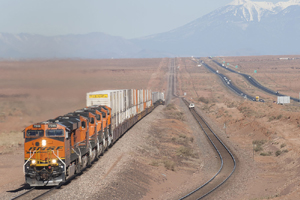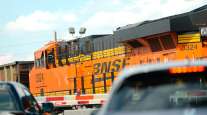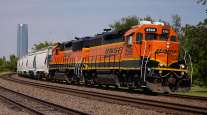BNSF Pressures Congress to Extend 2015 Rail Safety Deadline

BNSF Railway Co. is ratcheting up pressure on Congress to postpone a deadline for installing a safety system by the end of the year, saying it would probably have to halt freight and passenger traffic if the requirement isn’t delayed.
Congress mandated in 2008 that U.S. railroads install what’s known as positive train control, which can automatically stop a train to avoid a collision, by the end of 2015. But the major railroads have said they’re still years away from fully implementing it. Safety regulations trump BNSF’s obligation as a common carrier to haul freight for customers, BNSF said in a letter sent to Senate commerce committee chairman Sept. 9.
“BNSF is concerned that it is not reasonable to operate in violation of a legal safety requirement in order to fulfill its common carrier obligation,” said the letter, signed by BNSF CEO Carl Ice. “BNSF, as a matter of law, corporate policy and principle, does not willfully violate safety statutes or regulations or ask our employees to do so.”
BNSF said it expects to have “a significant portion” of the required PTC implementation by the deadline, but further installation and testing will still be necessary.
PTC will ultimately be deployed on about half of BNSF’s system, the company said, and those lines host about 80 percent of the freight the railroad moves.
Congress imposed the system on the railroads after a Los Angeles passenger train operated by a Metrolink engineer who was sending text messages collided with a freight train, killing 25 people in 2008.
BNSF said it could face legal claims for accidents on lines that didn’t comply with the PTC mandate. The railroad will notify customers if an extension isn’t enacted by the end of October to give customers time to develop alternative plans, BNSF said.
BNSF said it couldn’t meet the deadline, “despite our strong commitment to this technology,” because it had to develop the hardware and software from scratch. The railroads also lost more than a year waiting on permits to build radio towers. The railroads need more time to work out the bugs “in order to achieve successful PTC implementation and to avoid potential significant and unnecessary congestion and shipper service impacts,” the letter said.
Since 2008 BNSF has invested more than $1.5 billion in testing, development and installation of the positive train control components, out of a total estimated to exceed $2 billion, the company said. Railroads face fines and penalties if the system isn’t operating by the end of the year.
December 2018 would be a “more realistic” deadline for implementing PTC, the Association of American Railroads said Sept. 8. The freight railroads already have spent more than $5.7 billion on the system, the association said.
The Senate voted in July for an extension that requires having positive train control operational by no later than the end of 2018 in a transportation bill that needs approval from the House.
“We do believe that Congress will do the right thing and grant an extension, allowing us to continue serving our customer safely and efficiently,” Union Pacific Corp. Chief Financial Officer Rob Knight said on a conference webcast Sept. 9 about the PTC deadline.




